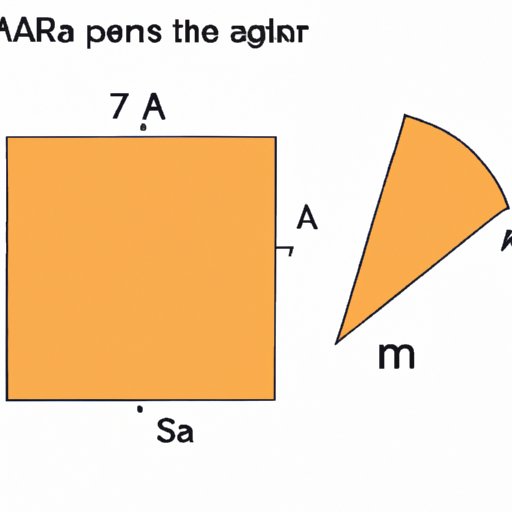
I. Introduction
Knowing how to find the area of a shape is an essential skill in both math and daily life. From calculating the area of a room to determining the amount of paint required for a wall, finding the area can be used in many practical applications. This article is a comprehensive guide that explains the basics of finding the area of a shape and explores advanced techniques. We’ll also provide real-world examples and practical strategies for using area to solve math problems.
II. Mastering the Basics: A Beginner’s Guide to Finding the Area of a Shape
Before diving into the more advanced techniques, it’s essential to have a good grasp of the basics. Area refers to the amount of space inside a shape, and it can be calculated using a formula specific to the shape.
For example, the area of a rectangle can be calculated by multiplying its length by its width. The formula for the area of a triangle is one-half of the base multiplied by the height. Finally, the area of a circle can be calculated by multiplying pi (approximately 3.14) by the radius squared.
It’s important to note that the units of area are typically squared units, such as square inches, square feet, or square meters.
To calculate the area of a shape, follow these steps:
- Identify the shape
- Measure the dimensions needed for the formula
- Use the formula for the shape to calculate the area
- Include the unit of measurement for the final answer
For example, to find the area of a rectangle with a length of 4 inches and a width of 6 inches, multiply 4 by 6 to get an area of 24 square inches.
When calculating the area of irregular or composite shapes (shapes made up of multiple shapes), it’s helpful to break the shape down into simpler shapes and add the areas together.
III. Alternative Methods to Find Area: Thinking Outside the Box
While the formulas mentioned above are the most common methods for finding area, there are alternative methods to consider. These methods can be especially useful for finding the area of irregular or composite shapes.
One such method is to use graph paper. Draw the shape on the graph paper and count the number of squares within the shape. Each square represents a small unit of area. Simply multiply the number of squares by the area of each square to find the total area of the shape.
Another useful method is to use physical objects as a reference. By placing small objects, such as paper clips or coins, within the boundaries of the shape, you can count the number of objects and use that as a reference for the area.
Remember, the key is to be creative and think outside the box when finding the area of a shape.
IV. Real-World Applications: Finding the Area in Everyday Life
Finding the area of a shape has practical applications in many areas of life. For example, calculating the area of a room can help you determine the amount of carpet or tile needed. Calculating the area of a wall can help you determine the amount of paint required.
Another application of finding the area is in gardening. By calculating the area of a garden bed, you can determine the amount of mulch needed and the number of plants that will fit in the bed.
It’s crucial to use math to solve real-world problems. By understanding the basics of finding area, you can apply this skill to many areas of your life.
V. Exploring Advanced Techniques: Finding Area Beyond the Basics
While the basic methods for finding the area of a shape are useful in many situations, there are situations where more complex methods are necessary.
A more advanced method for finding the area of a shape is calculus. Calculus allows you to find the area of irregular shapes, such as spirals or curves, by breaking them down into infinitesimally small pieces and adding up the area of each piece.
Another advanced method to consider is trigonometry. Trigonometry allows you to find the area of irregular shapes, such as a triangle, by using angles, sides, and trigonometric functions.
These advanced techniques may not be necessary for everyday situations, but they can be valuable tools in specific fields such as engineering, physics, and mathematics.
VI. Problem-Solving Strategies: Using Area to Solve Math Problems
The concept of area can be applied to solve math problems in geometry, algebra, and physics. When working on a problem that involves finding area, it’s important to identify all the given information, understand the relationship between the shape and the variables, and apply the appropriate formula.
For example, imagine you are working on a problem that asks you to find the area of a triangle. You are given the height and the base of the triangle, but you need to find the area. To do this, you can use the formula for the area of a triangle, which is one-half of the base multiplied by the height.
It’s important to note that the area of a shape can also be used to solve other variables. For example, in physics, the area of a shape can be used to find the moment of inertia or the center of mass. In algebra, the area of a shape can be used to solve for variables that relate to the area.
VII. Conclusion
Knowing how to find the area of a shape is an essential skill in both math and daily life. By mastering the basics, exploring alternative methods, and understanding advanced techniques, the concept of area can become a valuable problem-solving tool. Whether you’re trying to calculate the amount of paint needed for a wall or are working on a complex math problem, finding the area of a shape is a skill that will always come in handy.




